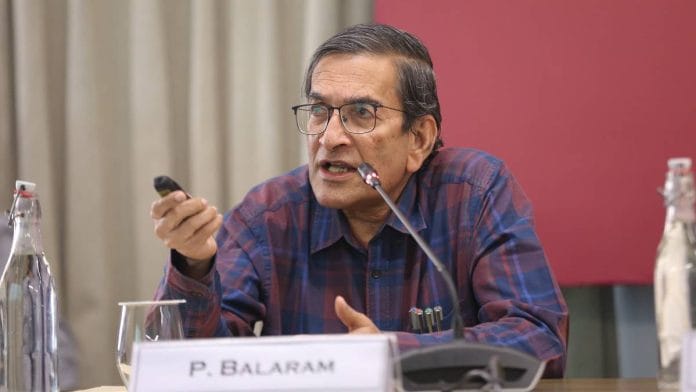New Delhi: Indian science has carved its identity in the global space by indigenising technology and making it cost-effective. Now, our scientists need to focus on the real-world applications of their research, said the former director of Bangalore-based Indian Institute of Science, professor P. Balaram.
“They need to see how their science and research impacts society,” Balaram said in an interview with ThePrint Tuesday.
As a biochemist, he has done pioneering work in molecular biophysics and chemical biology and is best known for his work on transmembrane peptide channels.
Below are some edited excerpts from the interview:
India landed on the moon last year and is preparing to send the first humans to space next year. We also had some pioneering research from Indian labs during the COVID-19 pandemic. But according to you, what was the period when science peaked in India?
Peaks in science have to be judged by the status of global science. Global science has advanced enormously in the last 50-60 years, and it is becoming harder for scientists in developing countries to keep pace with what is happening in the West. We have done very well in the applications of technology that had been developed much earlier and in taking this technology forward. We have also done noticeable work in indigenising technology and bringing down the cost of this technology. For instance, our space programme.
But when we talk about academic science, some of the work done in India a long time ago is difficult to match today. Work done in the 1950s, 1960s, 1920s and 1930s was of high calibre. We have a lot of catching up to do and we also need to look at how useful the science we do is to our surroundings.
Post-Independence India inherited a lot of challenges such as poverty and illiteracy. This was also the time when science was booming in the West. With such challenges, how did science evolve and develop in India?
In the post-Independence period, science developed in India primarily in universities and research institutions. There were many success stories from there. For instance, in the early 1970s, the agricultural Green Revolution was a major success. A scientific advancement like that was taken to the fields in India and is known to have impacted agricultural production. That certainly was a revolution. We have made advancements in basic science, which has had impact on the ground.
But we need to know that during that time, science also came from medical colleges and universities and not necessarily from big research institutions. Science can come from anywhere. That is something we need to keep in mind even now. That is why we need to practise science in many places. It should be like a thousand flowers blooming at the same time.
Science institutes and universities played a significant role post-Independence when science was taking shape in India. How do you think the role of these institutes has changed over the years?
The role of scientific institutes has changed dramatically over the years. This is because of many factors. I will take the example of my former institute, the Indian Institution of Science. The IISc has nurtured many programmes in India because it was positioned at the right place at the right time. In the late 1940s and, then, in the 1950s and 1960s, the growth of the aerospace industry in Bangalore can be traced back to IISc.
The Department of Space had a very close connection with IISc because (the late) Satish Dhawan was the head of both. The conception of the Department of Atomic Energy was done by (physicist) Homi J. Bhabha when he was at IISc. So, many institutes came out from the IISc. They were established in different parts of India, and they grew, and once they grew, these institutes had their own identities.
Do you think we have been able to overcome the issues of gender, class, race, etc., in science?
Is there gender discrimination in science? Many of us would like to think not. Today, for example, the number of women students who come into the biological sciences far exceeds the number of men. There will likely be a time when women will be driving the field. This is happening because women are choosing these subjects.
But this is a slow process. It is difficult to correlate this with the awards that go to women today.
(Edited by Nida Fatima Siddiqui)
Also Read: India’s first space station and human mission to Moon: what ISRO is planning after Gaganyaan






